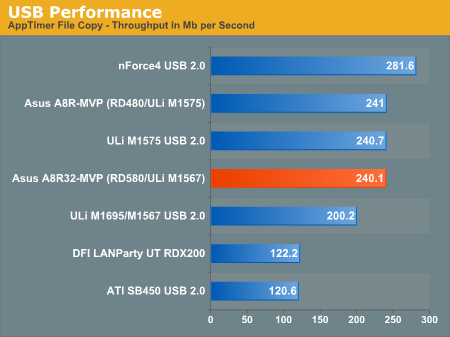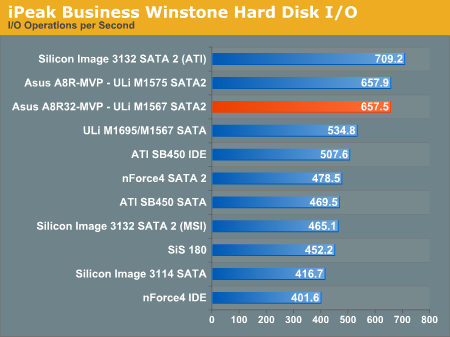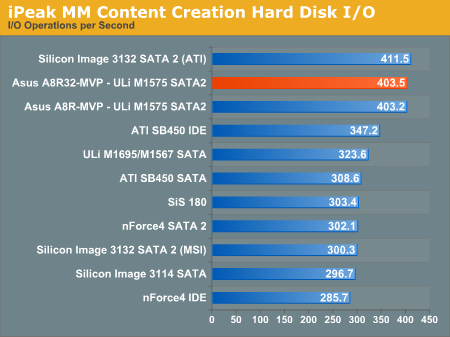Asus A8R32-MVP Deluxe: First ATI RD580
by Wesley Fink on March 1, 2006 9:00 AM EST- Posted in
- Motherboards
USB Performance
USB has been a problem area for the ATI SB450 chipset, but it has not been a major issue with the ULi M1575 southbridge. To test performance of USB on the A8R32-MVP, we ran our standard USB throughput test using an external USB hard drive.
Our test method uses a RAM disk as our “server”, since memory removes almost all overhead from the serving end. We also turn off disk caching on the USB and Firewire side by setting up the drives for “quick disconnect”. Our results are then consistent over many test runs.
We use just 1GB of fast 2-2-2 system memory, set up as a 450MB RAM disk and 550MB of system memory. Our stock file is the SPECviewPerf 8.01 install file, which is 432,533,504 bytes (412.4961MB). After copying this file to our RAM disk, we measure the time for writing from the RAM disk to our external USB 2.0 or Firewire 400 or Firewire 800 drive using a Windows timing program written for AnandTech by our own Jason Clark. The copy times, in seconds, are then converted into Megabits per second (Mb) to provide a convenient means of comparing throughput. Higher Rates therefore mean better performance.
In addition to competitive USB performance, the M1575 also provides the SATA2 ports missing from the ATI SB450. The ULi SATA2 also supports RAID 0, 1, 0+1, 5, and JBOD.
Disk Controller Performance
The AnandTech iPeak test was designed to measure "pure" hard disk performance using the Intel iPeak benchmark. The hard drive is kept as consistent as possible while varying the hard drive controller. The idea is to measure the performance of a hard drive controller with a consistent hard drive.
We played back Anand's raw files that recorded I/O operations when running a real world benchmark - the entire Winstone 2004 suite. Intel's iPEAK utility was then used to play back the trace file of all IO operations that took place during a single run of Business Winstone 2004 and MCC Winstone 2004. The drive was formatted before each test run and a composite average of 5 tests on each controller interface was tabulated in order to ensure consistency in the benchmark.
iPeak gives a mean service time in milliseconds; in other words, the average time that each drive took to fulfill each IO operation. In order to make the data more understandable, we report the scores as an average number of IO operations per second so that higher scores translate into better performance. This number is meaningless as far as hard disk performance is concerned as it is just the number of IO operations completed in a second. However, the scores are useful for comparing "pure" performance of the storage controllers in this case.
USB has been a problem area for the ATI SB450 chipset, but it has not been a major issue with the ULi M1575 southbridge. To test performance of USB on the A8R32-MVP, we ran our standard USB throughput test using an external USB hard drive.
Our test method uses a RAM disk as our “server”, since memory removes almost all overhead from the serving end. We also turn off disk caching on the USB and Firewire side by setting up the drives for “quick disconnect”. Our results are then consistent over many test runs.
We use just 1GB of fast 2-2-2 system memory, set up as a 450MB RAM disk and 550MB of system memory. Our stock file is the SPECviewPerf 8.01 install file, which is 432,533,504 bytes (412.4961MB). After copying this file to our RAM disk, we measure the time for writing from the RAM disk to our external USB 2.0 or Firewire 400 or Firewire 800 drive using a Windows timing program written for AnandTech by our own Jason Clark. The copy times, in seconds, are then converted into Megabits per second (Mb) to provide a convenient means of comparing throughput. Higher Rates therefore mean better performance.

In addition to competitive USB performance, the M1575 also provides the SATA2 ports missing from the ATI SB450. The ULi SATA2 also supports RAID 0, 1, 0+1, 5, and JBOD.
Disk Controller Performance
The AnandTech iPeak test was designed to measure "pure" hard disk performance using the Intel iPeak benchmark. The hard drive is kept as consistent as possible while varying the hard drive controller. The idea is to measure the performance of a hard drive controller with a consistent hard drive.
We played back Anand's raw files that recorded I/O operations when running a real world benchmark - the entire Winstone 2004 suite. Intel's iPEAK utility was then used to play back the trace file of all IO operations that took place during a single run of Business Winstone 2004 and MCC Winstone 2004. The drive was formatted before each test run and a composite average of 5 tests on each controller interface was tabulated in order to ensure consistency in the benchmark.
iPeak gives a mean service time in milliseconds; in other words, the average time that each drive took to fulfill each IO operation. In order to make the data more understandable, we report the scores as an average number of IO operations per second so that higher scores translate into better performance. This number is meaningless as far as hard disk performance is concerned as it is just the number of IO operations completed in a second. However, the scores are useful for comparing "pure" performance of the storage controllers in this case.












65 Comments
View All Comments
SuperStrokey - Friday, February 17, 2006 - link
i assume that was not the gtx512 was it? If so wowDeathBooger - Friday, February 17, 2006 - link
http://www.scan.co.uk/Products/ProductInfo.asp?Web...">http://www.scan.co.uk/Products/ProductInfo.asp?Web...If you do a currency conversion it's $217USD. Some lucky guy actually got to buy it before they were supposed to sell it. http://forums.overclockers.co.uk/showthread.php?t=...">http://forums.overclockers.co.uk/showthread.php?t=...
Egglick - Friday, February 17, 2006 - link
Why would you use two different videocards when benchmarking a motherboard?? This really tells us nothing about the motherboards performance in relation to the others, because you have another huge variable.Wesley Fink - Friday, February 17, 2006 - link
As we stated in the test setup we ran BOTH the 7800GTX and the X1900XT video card on the Asus A8R32-MVP. We reported both results so you could compare 7800GTX performance to the previous boards also tested with the 7800GTX. Since the X1900XT is the latest and fastest video card the results were included for Reference only - many would have asked for X199XT results if they were excluded.As someone else pointed out, when testing Dual X16 Video you have to run SLI on nVidia and Crossfire on ATI (or Intel).
andrewln - Friday, February 17, 2006 - link
because you can not run SLI in Crossfire motherboardstuteja1986 - Friday, February 17, 2006 - link
Why didn't Asus include the cool feel as they did with the ASUS A8N 32-SLI. Like the 8-Phase Power and the cool looking Fanless Motherboard cooling system.mino - Friday, February 17, 2006 - link
Just wondering. maybe 8-phase is a waste for ~60 watt Athlon64s. Also why do a fancy(an expensive) "cool looking Fanless Motherboard cooling system" when chipset is cool and doesn not need one at all???I.m glad someone has a sense and doesn't produce third central heater in the system(after CPU & GPU).
Hoping SB600 will be a good one.
Wesley Fink - Friday, February 17, 2006 - link
The RD580 chipset also ran very cool on this board, so there may not be the need for the more exotic passive heatpipe cooling used on the A8N32-SLI.Wesley Fink - Friday, February 17, 2006 - link
The A8R32-MVP was designed to sell for a lower price - probably around $130 to $150, where the A8N32-SLI was designed to sell for $200+. While the A8R32-MVP isn't 8-phase, it actually overclocked ba bit better and gave up nothing to the more expensive and excellent A8N32-SLI in performance. This board can also run dual X1900XT cards in Crossfire mode.tuteja1986 - Friday, February 17, 2006 - link
I wonder how much will it sell for and if it goes arround same price as Asus A8N 32-SLI (220ish). if it cost that much then i will end up buying DFI RD580 motherboard if its got no issue bugs like the 1st rev of DFI RD480 CRossfire.